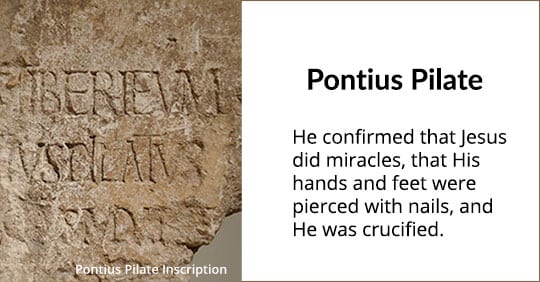Pilate’s Background
Pontius Pilate (unknown B.C. – circa A.D. 37) was the fifth Roman procurator of Judea (AD 26 – 36 ) under Emperor Tiberius, who sentenced Jesus to death by crucifixion. The quotes below refer to the Acts of Pontius Pilate. The existence of the Acts of Pontius Pilate is strongly supported by Epiphanius (Heresies 50.1), Justin Martyr (First Apology, A.D. 150 ) and Tertullian (Apology, A.D. 200). The Acts of Pontius Pilate were kept in the Roman archives, Commentarii principis, as stated in the following quote.
The ancient Romans were scrupulously careful to preserve the memory of all remarkable events which happened in the city; and this was done either in their “Acts of the Senate” (Acts Senatus), or in the “Daily Acts of the People” (Acta Diurna Populi), which were diligently made and kept at Rome . . . In like manner it was customary for the governors of provinces to send to the emperor an account of remarkable transactions that occurred in the places where they resided, which were preserved in the “Acts of” their respective governments . . . we find, long before the time of Eusebius [3rd century], that the primitive Christians, in their disputes with the Gentiles, appealed to these “Acts of Pilate” . . . Thus, Justin Martyr, in his first “Apology” for the Christians, which was presented to the Emperor Antoninus Pius [A.D. 138-161] and the senate of Rome, about the year [A.D.] 140, having mentioned the crucifixion of Jesus Christ and some of its attendant circumstances, adds, “And these things were done, you may know from the ‘Acts’ made in the time of Pontius Pilate.” [1]
It should be noted that fraudulent versions of the original Acts of Pilate were circulated later in the fourth and fifth centuries.[2] These should not be confused with the original document that was generated in the first century, archived in Rome and was available to Caesar Antoninus Pius and the Roman Senate. Otherwise, Justin Martyr’s appeal to the Acts of Pilate in his First Apology would have lacked credibility. Both Justin Martyr (A.D. 150) and Tertullian (A.D. 200) refer to the original document, and not the fraudulent versions.[3]
Pilate’s Reference To Jesus Christ
“And again in other words, through another prophet, He says, “They pierced My hands and My feet, and for My vesture they cast lots.” And indeed David, the king and prophet, who uttered these things, suffered none of them; but Jesus Christ stretched forth His hands, being crucified by the Jews speaking against Him and denying that He was the Christ. And as the prophet spoke, they tormented Him, and set Him on the judgment-seat, and said, Judge us. And the expression, “They pierced my hands and my feet,” was used in reference to the nails of the cross which were fixed in His hands and feet. And after He was crucified they cast lots upon His vesture, and they that crucified Him parted it among them. And that these things did happen, you can ascertain from the Acts of Pontius Pilate.” – Justin Martyr, First Apology 35
“And that it was predicted that our Christ should heal all diseases and raise the dead, hear what was said. There are these words: “At His coming the lame shall leap as an hart, and the tongue of the stammerer shall be clear speaking: the blind shall see, and the lepers shall be cleansed; and the dead shall rise, and walk about.” And that He did those things, you can learn from the Acts of Pontius Pilate.” – Justin Martyr, First Apology 48
Conclusion
This reference reveals several key things:
- Christ performed amazing miracles.
- Christ died on a cross with hands and feet pierced with nails.
- It affirms the fulfillment of the Old Testament prophecy.
References:
1. Cyclonic and Strong. Cyclopedia of Biblical, Theological, and Ecclesiastical Literature. 1867-1887. vol. 1, 62-63.
2. Philip Schaff. Nicene and Ante-Nicene Fathers. Hendrickson. 1995. vol. 8. pp. 459-463, 480.
3. Gary R Habermas. The Historical Jesus. College Press Publishing Company. 1996. pp. 215-216.
